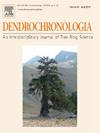用树木年轮蓝色强度探测朝鲜半岛树木生长对夏季温度的响应
IF 2.7
3区 农林科学
Q1 FORESTRY
引用次数: 0
摘要
树木年轮蓝强度(BI)是一种利用树木年轮核心反射的蓝光量的相对较新的替代指标,由于其在捕获气候信号方面的有效性,在树木气候学中引起了相当大的关注。虽然BI在气候重建中的应用正在全球范围内推广,但在东亚尚未得到充分的探索。在本初步研究中,对红松(Pinus koraiensis Siebold &;在韩半岛的雪岳山。虽然本研究中开发的BI年表显示出相对较弱的序列相互关系,但它们仍然捕获了重要且一致的夏季温度信号,证明了它们的树木气候学潜力。特别是,在局地和区域尺度上,δ BI (DBI)年代学与夏季(7 ~ 8月)平均气温具有较好的相关性。与TRW年表未能捕获一致的气候相关信号相比,DBI年表始终保留了树木生长对20世纪初至今夏季温度变化的响应。进一步的大尺度相关分析表明,DBI年表可用于全球距平型和副热带急流的历史重建。这些结果表明,应用BI方法可以显著增强树木年轮数据捕捉气候信号的能力,而这些信号在亚热带东亚的TRW中并不明显。本文章由计算机程序翻译,如有差异,请以英文原文为准。
Tree growth responses to summer temperature on the Korean Peninsula detected by tree-ring blue intensity
Tree-ring blue intensity (BI), a relatively new proxy using the amount of blue light reflected from tree-ring cores, has garnered considerable attention in dendroclimatology due to its effectiveness in capturing climate signals. While the application of BI in climate reconstructions is spreading across the world, it has not yet been fully explored in East Asia. In this pilot study, tree-ring width (TRW) and BI (earlywood BI, maximum latewood BI, and delta BI) chronologies were developed from Korean pine (Pinus koraiensis Siebold & Zucc.) on Mt. Seorak in the Korean Peninsula. While the BI chronologies developed in this study exhibited relatively weak series intercorrelations, they nonetheless captured significant and consistent summer temperature signals, demonstrating their dendroclimatological potential. In particular, the delta BI (DBI) chronology was well correlated with summer (July to August) mean temperature at both local and regional scales. In contrast to the TRW chronology, which failed to capture a consistent climate-related signal, the DBI chronology consistently retained the tree growth response to summer temperature variability from the early 20th century to the present. Further large-scale correlation analysis demonstrated that the DBI chronology can be used in the historical reconstruction of the circumglobal teleconnection pattern and the subtropical jet stream. These findings show that the application of the BI methodology can significantly enhance the ability of tree-ring data to capture climate signals that are not apparent in TRW in subtropical East Asia.
求助全文
通过发布文献求助,成功后即可免费获取论文全文。
去求助
来源期刊

Dendrochronologia
FORESTRY-GEOGRAPHY, PHYSICAL
CiteScore
5.50
自引率
13.30%
发文量
82
审稿时长
22.8 weeks
期刊介绍:
Dendrochronologia is a peer-reviewed international scholarly journal that presents high-quality research related to growth rings of woody plants, i.e., trees and shrubs, and the application of tree-ring studies.
The areas covered by the journal include, but are not limited to:
Archaeology
Botany
Climatology
Ecology
Forestry
Geology
Hydrology
Original research articles, reviews, communications, technical notes and personal notes are considered for publication.
 求助内容:
求助内容: 应助结果提醒方式:
应助结果提醒方式:


